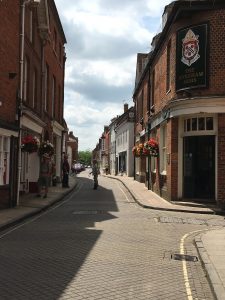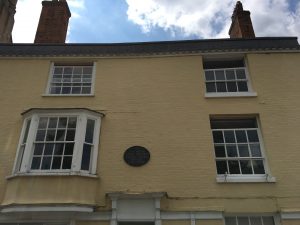At last the sun overpowered the clouds this morning, at least for awhile. It even caused me to remove a layer of sweaters! My destination today — Winchester Cathedral and other historic sights in the town center.
The Cathedral is significant to the town’s history: The seat of the Bishop was moved to Winchester from Dorchester-on-Thames in 676, and around 828 Winchester was named the capital of England. The building of the Norman Cathedral began in 1079 and was consecrated 1093 and the Old Minster building demolished. It’s a really large cathedral and the resting place for lots of Saxon royalty as well as St. Swithun and Jane Austen! The floor tiles are mainly 13thC and are the largest and oldest area of tiling to survive in England. The style of the tile changes in large sections and is quite beautiful. In the Holy Sepulcrhre Chapel some remarkable 12thC wall paintings have been uncovered and show the deposition and entombment of Christ. The original east end of the Cathedral was built upon a crypt which still floods at times. It contains a well which may pre-date the present Cathedral and a modern sculpture called “Sound II” which to me resembles a man checking his cell phone. Lastly, the Cathedral is home to 4 volumes of the Winchester Bible, the largest and finest of all surviving 12thC English bibles. It is illuminated in gold and lapis lazuli and was commissioned by Bishop Henry, the brother of King Stephen. A commission of this magnitude would’ve taken years to complete by many scribes and master artists.
As I strolled through the Cathedral the choir was rehearsing for a midday concert. It was quite beautiful to hear melodies wafting through the huge building, and I finally noted the specific tunes — first Penny Lane, and then Ob-la-di (or whatever that song is called from the Beatles). Strange selections I thought.
Across the road is Winchester College, not open for regular tours, but believed to be the oldest continuously running school in England, founded in 1382. And just past the college are the ruins of Wolvesey Castle, what had been the Medieval bishops palace. The name means “Wulf’s Island”, the higher ground between two streams of the River Itchen. The extent of the 12th C complex developed by Bishop Henry makes clear his enormous wealth and his powerful position. Throughout the medieval period the bishops of Winchester held one of the highest positions of power in the church and in politics. Henry of Blois was also the brother of King Stephen so had more reason and ability to continue to add rooms and fortifications to his palace. The current private home was built in 1680 and remains the home and office of the current bishop.
The streets in this part of town are narrow, old and very charming, I passed by the last residence of Jane Austen, and the quaint little Church of St. Swithun upon Kingsgate which had a small chapel (closed) and included a bridge over the road. Just off the High Street is Abbey House, which stands on the site of St. Mary’s Abbey, built in 1750. Benedictine nuns, fleeing the disturbances of the French Revolution made their home at this house in the 1790’s. It now serves as the home of the Mayor of Winchesters and backs onto some lovely gardens and the River Itchen.
The High Street bustles with foot traffic visiting the shops and eateries all along. After I stopped in the tourist center I discovered some other historic places to visit, but with 2 more days in Winchester i will now have something to do!

















